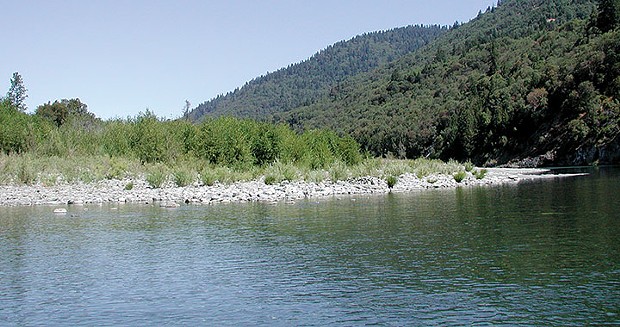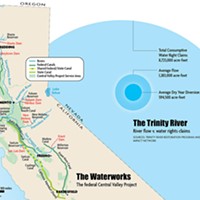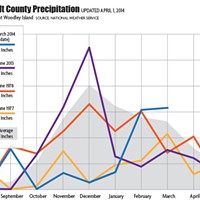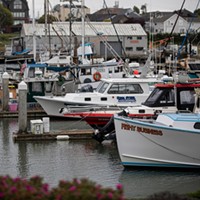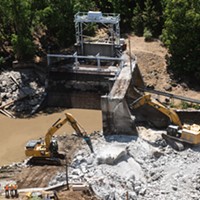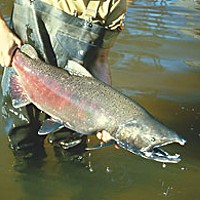Water's for Fighting
How California and the feds sold off more water than north state rivers usually hold
By Grant Scott-Goforth [email protected] @GScottGoforth[
{
"name": "Top Stories Video Pair",
"insertPoint": "7",
"component": "17087298",
"parentWrapperClass": "fdn-ads-inline-content-block",
"requiredCountToDisplay": "1"
}
]
When's the last time you visited the Trinity River?
Late spring, when the bathtub rings begin to appear on rocks near Kimtu, when crisp, warm air and cold, fast flows combine to beckon swimmers?
Late August, when the canyon walls are bleached, baked and orange-hued from overhead wildfire smoke?
Winter, when the water pours into the river from every stream, rivulet and stone, carving an ever so slightly deeper canyon, clearing sediment from holes and thrusting boulders downstream?
The Trinity never would have carved its way out of the mountains in such spectacular fashion without the Trinity Alps' snowmelt and dozens of tributaries that feed it every year; never would have been home to hundreds of thousands of salmon, and the animals and native people who relied on them.
But although the Trinity flows mightily into the Klamath River each year, much of the river's water is siphoned off, part of California's massive restructuring of the state's natural water flows. Only in the last two centuries has the flood of human ingenuity — sometimes praised, sometimes scorned — changed how California uses and understands water, from the Trinity to waterways far beyond.
A surge of European immigrants flocked to California to seek gold in 1849, but it was water that soon became one of the state's most valuable resources. Who got the water — and who didn't — could spell the difference between growth and stagnation, between plenty and poverty. The winners and losers depended on who had water rights — the legal right to use a waterway or divert some of its flow elsewhere.
There are two basic forms of water rights. Riparian water rights are based on English common law and basically say, "If a stream runs through your property, you can use it." That principal can make sense in wet climates, but it doesn't help farmers who don't own riverfront land.
Appropriative water rights are more common in the Western U.S. (Oklahoma and California are the only Western states that continue to recognize riparian rights.) These rights say water can be moved as long as it's being put to good use, whether for farming, fishing, mining or municipal use. Appropriative rights, which began being granted in California in 1914, are typically secondary to riparian rights.
"California has an almost unpredictable mix of those two," said UC Berkeley Water Center Executive Director Carolyn Remick. That combination, along with statewide exchanges and deals over the last 100 years, make for a convoluted rights system overseen by the State Water Board.
As California grew, the State Water Board awarded water rights to the state and federal governments to build two vast water projects, promising even more water from the north state's rich runoff to be delivered through a network of dams and canals. When environmental consciousness began to roil over lost fish and dewatered streams, lawsuits and government rulings began narrowing the spigot, allowing less and less water to be siphoned away for agriculture and increasing the water given to fish and the environment.
Today, powerful water brokers have made contracts that promise far more water than nature can deliver — particularly in the face of growing populations and climate change. Much of that water moves through the two major projects that define California's waterscape. The Central Valley Project, run by the federal government, and the State Water Project collect water behind dams and move it through rivers, pipes, pumps and canals. These storied channels, carved out of the dry California earth, feed one of the richest agricultural plains in the United States. What started as collaborations among small farmers grew into powerful irrigation districts that supply large ag producers. And all the while, farmers, fishermen, tribes and local governments have been fighting over the right to store, release and reroute water.
The result: a torrent of lawsuits when the water dries up. This year, which set dryness records in the Sacramento and San Joaquin river basins, the Hoopa Tribe and fish advocates joined the federal government in fighting off a lawsuit over Trinity River water brought by powerful Central Valley irrigators.
The Trinity River is split in two ways: The Bureau of Reclamation controls storage of Trinity water and has state-granted rights to sell it to irrigators, cities and industrial users. But there are certain guarantees for downstream flows to protect fish and tribal fishing, based on orders from the Bureau's parent, the U.S. Department of the Interior. Those guarantees were made when the dams were built to ease concerns about the Trinity being sucked dry, and flows increased in later years when environmental impacts came into sharper focus.
In this way, the state's water is tangled up in a net being pulled from many sides, and a new, governor-approved proposal for the Sacramento River Delta has people from Hoopa to Stockton up in arms.
So why does Southern California get to drink our milkshake?
With fresh statehood, the California legislature in 1850 adopted riparian water laws, and land purchases along Central Valley waterways limited many landowners' access to water.
In the late 1870s, a state engineer was hired and work began on ways to draw water from the state's lush Sacramento River to the arid San Joaquin Valley and farther south. From north of Redding, the Sacramento wends its way south and meets with other tributaries — including the Feather and American rivers, pouring off the Sierra Nevada mountains — before entering the Pacific Ocean through the marshy wetlands of the delta in northeast San Francisco Bay.
After decades of legislation (including the controversial establishment of regional irrigation districts) and a variety of proposals and approvals of dams and canals, the state called for a comprehensive Central Valley Plan in the 1920s. But even with approval of $170 million in bonds, the state couldn't afford it, so it turned to the federal government. In 1935, President Franklin Roosevelt approved funding for the Central Valley Project — part of the New Deal wave of building projects — and construction began.
The federal Central Valley Project is a massive complex of dams, canals, tunnels and pumps that stores Sacramento River water. Just upstream of the delta, the Bureau of Reclamation routes some of that water to the San Joaquin Valley.
Meanwhile, the Trinity River was being eyed as part of a continuing effort by the state to have its own water project. But in 1945, California dropped the Trinity portion of its State Water Project. This prompted headlines on the North Coast heralding the assurance of Humboldt County's water supply, but the enthusiasm was short-lived. When the state wrote the Trinity off, the feds picked it up as part of its Central Valley Project. The Whiskeytown Dam, a transfer point for Trinity water on its way to the Sacramento, was dedicated by President John F. Kennedy in 1963.
From Trinity Lake, water flows through a series of pumps, power plants and tunnels in its journey through the Trinity Mountains. Trinity Lake — with a storage capacity of 2.5 million acre-feet of water — is the starting point for the annual diversion of hundreds of thousands of acre-feet south. From 2000 to 2010, Reclamation pumped nearly 7.8 million acre-feet of Trinity Reservoir water to the Central Valley. During that same period, 6.2 million acre-feet were allowed to flow downstream.
Trinity Dam water runs through a power plant and on to Lewiston Lake, where it's released to the west or pumped into Whiskeytown Lake. From there, it tumbles down to the Keswick Reservoir, which holds back the Sacramento River north of Redding.
All told, Trinity River water drops about 1,800 feet from Trinity Lake to the Sacramento River bed, producing vast amounts of energy in Reclamation power plants.
It's a source of pride for its engineers and controversy for those who have been fighting for their share of the water. In the course of divvying up a newly tapped treasure trove of water, Reclamation began promising water to irrigators up and down the Central Valley. All told, in 1963, the bureau awarded contracts for more than 8 million acre-feet of Trinity River water. Water that in 50 years' time would be impossible to deliver.
"Paper Water"
The Bureau of Reclamation doles out water each year to its contractors — Central Valley irrigators, cities and industrial users. But Reclamation hasn't delivered 100 percent of the water promised in those contracts in more than 20 years.
When the Central Valley Project was being developed, the Bureau of Reclamation began making contracts to sell water to irrigators. In its effort to gain water rights, Reclamation made "exchange" contracts with irrigators who had riparian rights on the east side of the San Joaquin River. By giving up the right to draw water directly from the river, those farmers were given contracts for more secure water through the Central Valley Project, explained Reclamation spokesman Pete Lucero.
Reclamation also made similar deals with users north of the Delta who would draw from the Sacramento River. Those deals resulted in many senior claims to water — essentially first place in line — for those irrigators.
And while some of its customers regularly get their full water complement, those with junior water claims are given small percentages. In the Central Valley Project, that's irrigators on the west side of the San Joaquin Valley (such as Westlands Water District), which were among the last contractors with Reclamation and so have junior water rights. "They came late to the party," when the Central Valley Project was completed in 1963, Lucero said. Now, Reclamation has more than 250 contracts attached to the Central Valley Project.
That discrepancy between the amount of water available and the amount of water promised is what the California Water Impact Network calls "paper water."
The Network is a nonprofit environmental law and policy group that seeks environmental protection of the Bay Delta and other California waterways through policy and litigation. The organization has filed lawsuits over environmental irrigation practices, endangered and threatened species, and has been critical of the state's billion-dollar Bay Delta restoration plan.
And while "paper water" is sometimes a source of strife, with water users pulling at the supply from both ends of the state, Berkeley Water Center Director Carolyn Remick said it's actually meant to prevent disputes.
Think of it this way: Reclamation's contracts represent California waterways when they're completely saturated — a glass 100 percent full. If and when the state gets a year that wet, that water is spoken for.
If the glass was full and the water wasn't 100 percent spoken for, it could spur furious grasping for the leftovers.
It's not bad science that created those over-allocations, Remick said. "Really it's planned for when there's a wet year. Anticipating that there's an excess. It's optimism — and 'how do you prevent a scramble?'"
Water rights claims for the Trinity River are nearly seven times the amount of available water supply, according to a 2012 report by the California Water Impact Network.
"In plain language," the report reads, "this means there is really very little if any water available to the Central Valley Project and the State Water Project at any time."
Because California winters rarely deliver a full glass of water, the Bureau of Reclamation forecasts each year's water supply and issues curtailed portions of contracted water to Central Valley contract holders.
Tom Stokely of the California Water Impact Network put it bluntly. "They will never get 100 percent of their water contracts," he said. "This is not a new phenomenon. They've been sweeping it under the rug for years."
Central Valley Project water was over-allocated by the time Trinity River water began flowing into the Sacramento River, Stokely said. And it's gotten worse since then.
In the early 1980s, Interior Secretary Cecil Andrus ordered the federal dam operators to increase flows down the Trinity to benefit fish.
In 1991, Reclamation was ordered by the Department of the Interior to make the Trinity's permanent flow larger — from about 120,000 acre-feet per year to an average of 340,000 acre-feet per year — though the Trinity wouldn't see those flows until 2000, when the federal government adopted a record of decision.
In 1992, Congress granted extra water for Central Valley wetlands and Sacramento Delta fish, further reducing Reclamation's available water.
In the last 32 years, Reclamation began to give back more than 1 million acre-feet of water to the environment, "yet there's no adjustments to water contracts or water rights," Stokely said.
Over-allocation is far from exclusive to the Trinity or to the Bureau of Reclamation. A state plan to dam the Eel River in Mendocino — adding 5 million acre-feet to the State Water Project's resources — was undone when then-Gov. Ronald Reagan designated the Eel River "Wild and Scenic," thwarting the project.
More than five times the available water in the Sacramento River and San Joaquin River basins is claimed by state and federal rights holders, according to the California Water Impact Network report.
"Most streams are over-allocated," said Berkeley Water Center Executive Director Carolyn Remick. "Every river system I've worked on it's been a problem."
Over-allocation is widespread, Reclamation spokesman Pete Lucero agreed. While Reclamation is always working to make its water delivery more efficient and meet every claim for water, each contract was written with conditions for dry years. That means shortages for many water claimants — usually those with junior, or secondary claims to the water. Reclamation has varying rates depending on the size of the contract (2,000 different rates for 250 contracts), but Lucero said no west San Joaquin Valley users have a preferred contract.
Each year Reclamation predicts how much water it will be able to deliver to its claimants, notifying them by March 1. That calculation is based on how much water is left in reservoirs from the previous year, wintertime rainfall, snowpack in the Sierra Nevada and other mountain ranges, and a forecast of the rest of the year's rainfall and weather patterns.
"This year was particularly challenging," Lucero said. Rainfall in November and December 2012 was great, but come January "it flat dried out."
In fact, the five-month period from January to March was the driest on record for runoff into the Sacramento and San Joaquin watersheds, according to the state Department of Water Resources. That record goes back 90 years.
Still, Reclamation will meet its commitments made this year, Lucero said. But it's getting harder and harder. "It's been quite a while since certain contractors have had 100 percent allocation," Lucero said. "When allocations and contracts were first developed, the population of the state was lower. We've got this issue of climate change as well. We're not seeing as much rain and snow as we've had in the past."
And new obligations exist, in the form of changing public values in the decades since the Central Valley Project was conceived and completed. Dams used to be symbols of prosperity, jobs and population. Now, Lucero said, the state and public have realized the importance of protecting species and resources threatened by dams new and old, while being able to provide water to human users where it's needed.
Lucero was matter-of-fact about the over-allocation of water. "We're talking about a project that's 60 years old now," he said. "Things have changed now. There's more people. There's more development. And there's a finite resource."
Changing water contracts would require state legislation, Lucero said, and Reclamation doesn't think adjusting contracts is necessary. Contracts already account for low water years — it is allowed to deliver less water to customers if it's a dry season. "The contract amount of water is what it is," Lucero said. "But we deliver based on the water available."
But Stokely said Reclamation isn't interested in adjusting its water contracts because it would mean an admission that the bureau doesn't have as much water as it says. "If they revise their allocations, they're in for a big fight," he said, adding that water users, not taxpayers, come first. "The Bureau's essentially controlled by the water users — they're the quote-unquote clients."
Lucero said he didn't know how to address the criticism. "I can't qualify or verify that those claims are correct at all. I really can't comment on what other people claim to be their truth."
Stokely spent 10 years with the California Water Impact Network trying to convince the federal government to make Reclamation's Trinity water rights reflect the increased flows granted in 2000 by the Department of the Interior. But currently, there's a 474,000 acre-foot discrepancy between what's in Reclamation's water permit and what it is actually allowed to pull out of the river because of added environmental requirements, he said. "After millions of dollars and 10 years, the federal consultant never produced a viable solution."
Hampering the efforts to adjust allocations to numbers based on reality are the powerful Southern California Water interests, Stokely said. The five-person California Water Board, which could revisit water claims, is appointed by Gov. Jerry Brown, and "they're never going to make a decision that makes the governor unhappy," he said.
Reclamation isn't taking a stance on allocations, Lucero said, focusing instead on conservation and efficiency. "Those who really need the water are really conscious of conservation," he said. For example, Lucero said, the Central Valley agriculture industry has largely forsaken water-intensive flood or sprinkler irrigation for drip lines.
It's impossible to trace exactly how many gallons of Trinity water end up at any particular farm or faucet across California, but damming the Trinity provided the paper water that has given added leverage (and sometimes even water) to Central Valley irrigators ever since, according to water analyst Tom Stokely.
Raising the most controversy are water agencies south of the Bay Delta, including the Westlands Water District and the San Luis Mendota Water Authority, which recently sued Reclamation over its plan to send water down the Trinity at the request of environmentalists, government officials and the Hoopa and Yurok tribes.
The crux of that lawsuit is a nearly 60-year battle over 50,000 acre-feet of Trinity River water.
In 1955, in a hurry to authorize the Trinity River division into the Central Valley Project, lawmakers made a compromise: Trinity River water could go to the Central Valley so long as "not less than an annual quantity of 50,000 acre-feet will be available for the beneficial use of Humboldt County and other downstream users."
On top of that, said Hoopa Tribal Fisheries Director Mike Orcutt, Reclamation signed a contract with Humboldt County assuring the delivery. "Since that project's been in place there's never been that release," he said. Reclamation confirms that the 50,000 acre-feet has never been released.
"Downstream users" — fisheries, tribes and environmentalists — and government officials have called for the release of that water several times in the last decade following a Klamath River fish kill that could have been prevented by the release, the groups say. Reclamation released extra flows in August of 2012 and was preparing to do so again this August when a Fresno judge issued a temporary restraining order against the release.
Westlands Water District and the San Louis Delta Mendota Water Authority sued Reclamation to stop the release, saying it was a waste of water to let it flow to the Pacific Ocean instead of keeping it in reserve for next year's summer season. After testimony from the Hoopa and Yurok tribes, the judge lifted the restraining order and allowed a smaller release.
As to be expected, perhaps, given the politics of water, both sides claimed victory. Reclamation, tribes and fishermen said the extra flows — which they say were necessary to prevent the deaths of thousands of chinook salmon — were just. Irrigators said the judge's release of flows was far less total water from the reservoir that the defendants had initially asked for.
Reclamation owns the rights to Trinity River water, and both downstream users and Central Valley irrigators are claimants. And while Humboldt County has senior claims to the water, people on the North Coast say Westlands and other Central Valley interests wield the money and political clout to pull water southward. Westlands spokeswoman Gayle Holman declined to comment on the Trinity River water — citing the ongoing litigation — or the water district's position on water conflicts in California in general.
Orcutt said tribal elders recount tales of Reclamation's representatives assuring Humboldt County water. "'All you have to do is call us up and we'll release the water downstream,' they said. Yeah — we called up — and we're immediately in court 400 miles away from our reservation," Orcutt said.
Orcutt acknowledges that Westlands and other users face serious problems with the increased demand for water. Their customers, some of California's biggest agricultural producers, were essentially created by Reclamation. Without water from the Central Valley Project and State Water Project, the dry western San Joaquin Valley would never have become the farming powerhouse it is today. And now, water-strapped Central Valley agriculture is an industry worth billions.
Let the Central Valley have some Trinity water, Orcutt said, but Humboldt County needs that 50,000 acre-feet. The Hoopa Tribe doesn't have the resources to continue going to court to fight for water Humboldt County was guaranteed in the 1950s, and Orcutt hopes current litigation brought by Westlands and pressure from Humboldt County supervisors and Congressman Jared Huffman will force the courts — or the Department of the Interior — to permanently grant Humboldt County the long-disputed 50,000 acre-feet.
Bay Delta Tunnels
That north-south tussle is coming to a head in the highly controversial Bay Delta Restoration Project, which has given Trinity River advocates the perhaps unlikely allies of Central Valley irrigators in the northern part of the state.
The Bay Delta Conservation Plan is a proposed set of massive tunnels that would transfer water the Sacramento River just before it flows into the bay to the waterways in the southern half of the Central Valley. Conceived by the state and Reclamation — with approval from Gov. Brown — the plan aims to help restore the Delta and its plant and wildlife while increasing water flows to the south.
But opponents say the multi-billion dollar plan is just another attempt to increase Southern California's access to Sacramento River water that simply doesn't exist.
There's a bottleneck of water deliveries at the delta, said water analyst Tom Stokely. "Anything to clear that bottleneck will serve to drain northern reservoirs and fill southern reservoirs," he said. "This may happen anyway under climate change, but it will hasten the emptying of reservoirs."
While the project doesn't include plans to take more water from the Trinity, Stokely said that Reclamation needs every drop of water it can get — including that disputed 50,000 acre-feet — to justify the Bay Delta plan. As currently proposed, the Bay Delta recovery model includes that water.
Hoopa Fisheries Director Mike Orcutt said that's a reason to get a judge to recognize Humboldt County's right to the water, and soon. "We need to get it on our side of the ledger here."
Joining many opponents of the Bay Delta project are some Central Valley irrigators — those north of the delta, at least.
John Herrick serves as an attorney for the South Delta Water Agency, which doesn't supply water to irrigators but serves as a legal and political entity for water users in southern San Joaquin County who rely on Sacramento River delta water. More water pumped out of the delta stands to make their water stagnant, salty and unusable. "It's sort of life or death for us," he said.
Claims that the Bay Delta Project will increase the health of the delta just don't stand up when fresh water is expected to be pumped south before it reaches the delta, Herrick said. It's simply a push from state contractors in the Bakersfield and Los Angeles areas, as well as Reclamation contractors in the Central Valley, to increase access to the Sacramento River. "They continually have to press the bounds of acceptance to get enough water."
"The sad part is California has insufficient water to provide for the needs of the exporters," Herrick said. "Everything is a redistribution or a theft of someone else's water. There's one of those general rules in life: If the exporters are on one side, the right ones are on the other."
Asked about north state critiques, Westlands spokesman Holman began to compare water politics to muddied waters, before declining to comment. "We just need to pass on it," she said.
With this year's release flowing downstream, it's up to Westlands whether it will pursue its lawsuit for a long-term judgment on the 50,000 acre-feet of water.
North Coast interests — including Congressmen Jared Huffman, Mike Thompson and George Miller — continue to pressure the Department of the Interior to commit to that release. In an op-ed in the San Francisco Chronicle last week, Huffman chastised Reclamation, writing that the Department of the Interior "has been dithering for years" in granting Humboldt County its owed 50,000 acre-feet. Reclamation has issued no response to the Congressmen's request earlier this year, Huffman wrote.
Meanwhile, people are reveling in the last days of summer river fun. The salmon are pouring into the Klamath, soon to be swimming up the Trinity to spawn and die. While Californians fight to keep that cycle of life turning, the only certain thing is the continuing struggle over California's water.
This article contained an error on publication and a correction has been made.
Speaking of...
Comments (7)
Showing 1-7 of 7
more from the author
-
Flamin' Hot's Stale Corporate Propaganda
- Jun 15, 2023
-
Hell is Visiting Other People
- Sep 22, 2022
-
The Bear Roars
- Aug 18, 2022
- More »
Latest in News
Readers also liked…
-
Through Mark Larson's Lens
A local photographer's favorite images of 2022 in Humboldt
- Jan 5, 2023
-
'To Celebrate Our Sovereignty'
Yurok Tribe to host gathering honoring 'ultimate river warrior' on the anniversary of the U.S. Supreme Court ruling that changed everything
- Jun 8, 2023
